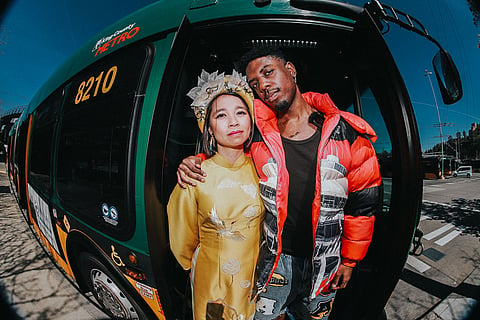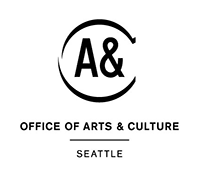From the Silk Road to the 36 Bus: New Wing Luke Exhibit Imagines South End Utopia
For more than 1,500 years — from roughly the 2nd century B.C.E. to the 15th century A.D. — Europe, Africa, the Middle East, and Asia traded goods, ideas, diseases, and culture along the Silk Road. Specifically, South and Southeast Asia, the Arabian Peninsula, and East Africa were connected by the Maritime Silk Road, where merchant sailors navigated oceans to bring goods from one country to the next.
In Paradice Avenue Souf's (PAS) latest exhibition, "Back Home: Utopia in Seattle," at the Wing Luke Museum, the Maritime Silk Road serves as inspiration for the clothing brand/creative agency. Highlighting emerging artists from the city, PAS, based in the South End, finds connections between Black and Brown communities across time, water, and along Seattle bus lines. Photography, delicately rendered gold-leaf paintings, and illustration are all highlights in the show. From last fall to this spring, PAS conducted an apprenticeship program, where a selected group of emerging artists took workshops with established artists from around the city, to help the emerging artists consider how to push their work and careers forward.
Similar to the multicultural mix along the original Silk Road, Seattle's South End is home to diverse cultures — Black, Filipino, Vietnamese, Ethiopian, and more — that live beside one another, intermingle, and create new connections. I spoke to two of the featured emerging artists and PAS apprentices, Jommel Pastores and Zion Thomas, about their practices, featured work, and their thoughts on Seattle's diverse communities.
These interviews have been condensed and combined for clarity.
How would you describe your artistic practice?
Jommel Pastores: I try to capture a lot of the whimsy and chaos that comes with life, and also highlighting certain parts of my upbringing and world, and the things that I have interests in that don't get a lot of love from a lot of people.
I grew up in a Filipino household with immigrant parents, and you see a lot of the world and see that you don't really get noticed a lot as a Filipino. I remember growing up watching all the cartoons like Adventure Time or Dexter's Laboratory, and you don't see someone who's like you. Then you go to school and you don't really learn your history or much about your culture — minuscule things. And the Asian kids in your class, there's only one or two other kids that are also Filipino. I just felt not as seen as other kids.
Zion Thomas: At the core of it, [my practice] is an act of celebration. Especially with being born and raised in the South End, a lot of my art — or more so my photography practice — started out as a love letter to my community. It was really all about highlighting and showcasing the beauty of South Seattle and South Seattleites. Being able to help tell the stories of people that are often the most overlooked in the city. My photography ended up becoming somewhat of a visibility project to amplify voices, the beauty, and people from my neighborhood. Then that naturally just evolved into a lot more. With this project, a lot of the exhibit is about world-building and creating utopia here in Seattle. A lot of my personal vision is really tied to those elements of visibility and community and storytelling, but it's also about radical optimism.
Jommel, can you tell me a little bit about [your piece] "Enjoy your Meal," (which talks about ketchup!)?
JP: During our apprenticeship [with Paradice Avenue Souf], we took inspiration from Silk Road trade throughout Southeast Asia to Asia, all the way to Africa. We thought about different things and different dishes we ate in our culture. I thought about banana ketchup, which is a quintessential Filipino household condiment. I used it on everything: I was a picky-ass kid. I had ketchup sandwiches. It was bad.
The basis of "Enjoy Your Meal" at its core is about honoring a simple childhood condiment that I really love, that some people don't know about. The reasoning beyond that, too, is just like the way it was made, its history. The person who made it, Maria Orosa, was like a food chemist. She was revolutionary in the food technology scene and in the Philippines in general. She was this humanitarian who wanted to really help all the people in the Philippines because, at that time, they were really heavily reliant on U.S. imports. But like, the Philippines itself had a bunch of their own resources they could use. She wanted to make the Philippines a bit more self-sufficient. And, fun fact: She came to America for her schooling and went to UW of all places. So it's very coincidental that this major food lady is historically tied to Seattle as well.
Zion, I love your photo shoot that was featured. How did you shoot that for this exhibition?
ZT: The project is called Silk Road Express. A lot of the inspiration for Silk Road Express comes directly from the clothing that Paradice actually released before. I had the opportunity to be inspired by their movements and what they're already doing and adding to it.
I took inspiration from some of the clothing that I've seen, in particular, one of my fellow cohort members would come into some of our meetings with a 36 Paradice bus T-shirt. And while we were using some of the notes that Paradice were implementing for some of their previous exhibitions and art pieces for Wing Luke, a lot of it was about being able to look at the Silk Road in particular for inspiration, [but] also just this pioneer of blending and being a bridge for Black and Brown and Asian solidarity, absolutely. So being able to observe historical ties and connections between Black and Asian communities, and then also being able to observe similar parallels here in Seattle, and seeing that bus T-shirt from Paradice, it kind of clicked as an idea.
I felt like using all of the inspiration that was around me, I felt like it would be smart to think about South Seattle and International District bus routes as remnants of the Silk Road. If you go on the 106, if you go on the 36, if you go on the 7, and you're heading to Chinatown, you'll see this beautiful parade of folks of color on the bus in their own little worlds. I wanted to capture that beauty, capture that frozen moment in time of being on the bus and all the culture and the beauty that's around you, being in South Seattle, being in the CID, and being able to turn that into a project that speaks to people.
How do you see this exhibition reflecting Seattle?
JP: Something we talked about during the internship is that Seattle's a bit of a sanctuary city. There's so many different people and cultures here in all the different neighborhoods, like Beacon Hill, Chinatown-International District, Central District, Pioneer Square, Capitol Hill, too. Like all these marginalized people coming together, especially at a time that we're facing the Trump administration, deportation, ICE, and the recent bit with Bruce Harrell and SPD surveillance. It's gotten so hard to live here for everyone, if you're not a white person living up in Ballard or something. The whole point of this exhibit was to show the people who actually live here, the people who grew up taking the bus like the 36, the 60, the 7, going through like the South End and Rainier Beach. And highlighting how we live despite the bullshit that we go through every day as a result of rich people who get their rocks off being cruel to others.
What did it mean for you to create an exhibit work in this show that's specifically about Black and Asian Pacific American communities here in Seattle?
ZT: This city is not always the most inclusive or the most forgiving or kind to South Seattleites. That's always been a throughline for me and my experience of South Seattle. Being from there and repping it so hard, there was a point where sometimes representing Rainier Beach in particular meant kind of donning a scarlet letter. There's always been this narrative that people are going to write off Othello, Rainer Beach, Hillman City, Rainer Vista.
Being able to create this art piece really speaks to the natural bridges that already occur here in South Seattle. I remember growing up here and hearing the term "sanctuary city," just walking around the South End: There's a Vietnamese restaurant right here, there's a Somali restaurant right here, there's a Filipino spot, there's my dad's restaurant. There's all this culture that's naturally around you that you don't have to force. Especially with our current president actively threatening sanctuary cities and really putting targets on a lot of their protections that folks of color really leaned on, I wanted to make a project and a statement that said, "I don't give a fuck what y'all have to say or what y'all are trying to do. We're not going anywhere."
[Silk Road Express] is about honoring South Seattle, South Seattleites, and putting a crown on our heads. Saying that, no matter what happens, you can't change the fact that we're always going to be a sanctuary city, whether you take away our protections or not.
Wing Luke Museum
719 S. King Street
Wed.–Sun., 10 a.m.–5 p.m.
Admission: Adults, $17; Seniors (62+), $15; Students (13–17 or 18+ w/ID), $12:50
This article is published under a Seattle Human Services Department grant, “Resilience Amidst Hate,” in response to anti-Asian American, Native Hawaiian, and Pacific Islander violence.
The Emerald's arts coverage is supported in part with funding from 4 Culture and the City of Seattle's Office of Arts & Culture. The Emerald maintains editorial control over its coverage.
Help keep BIPOC-led, community-powered journalism free — become a Rainmaker today.




